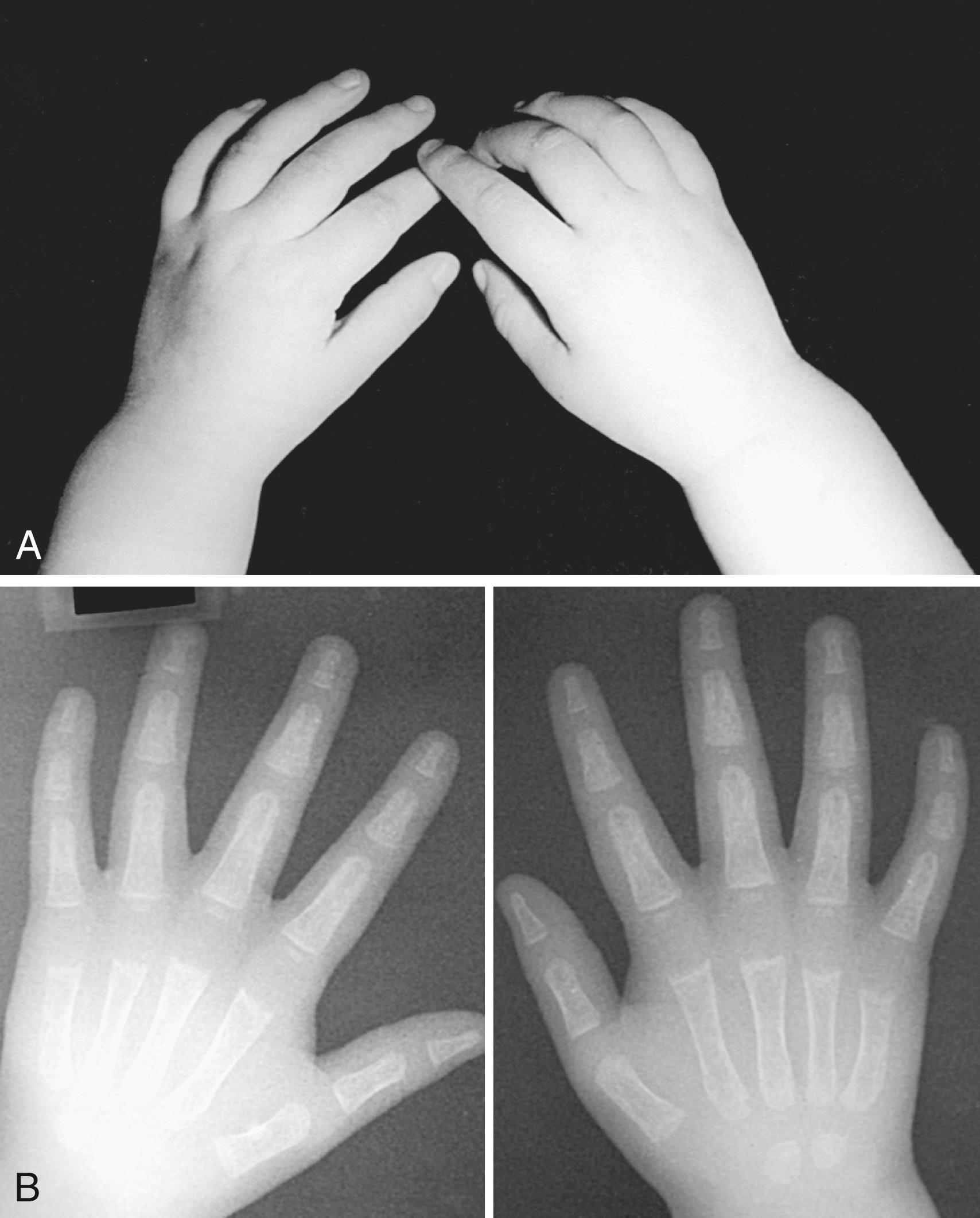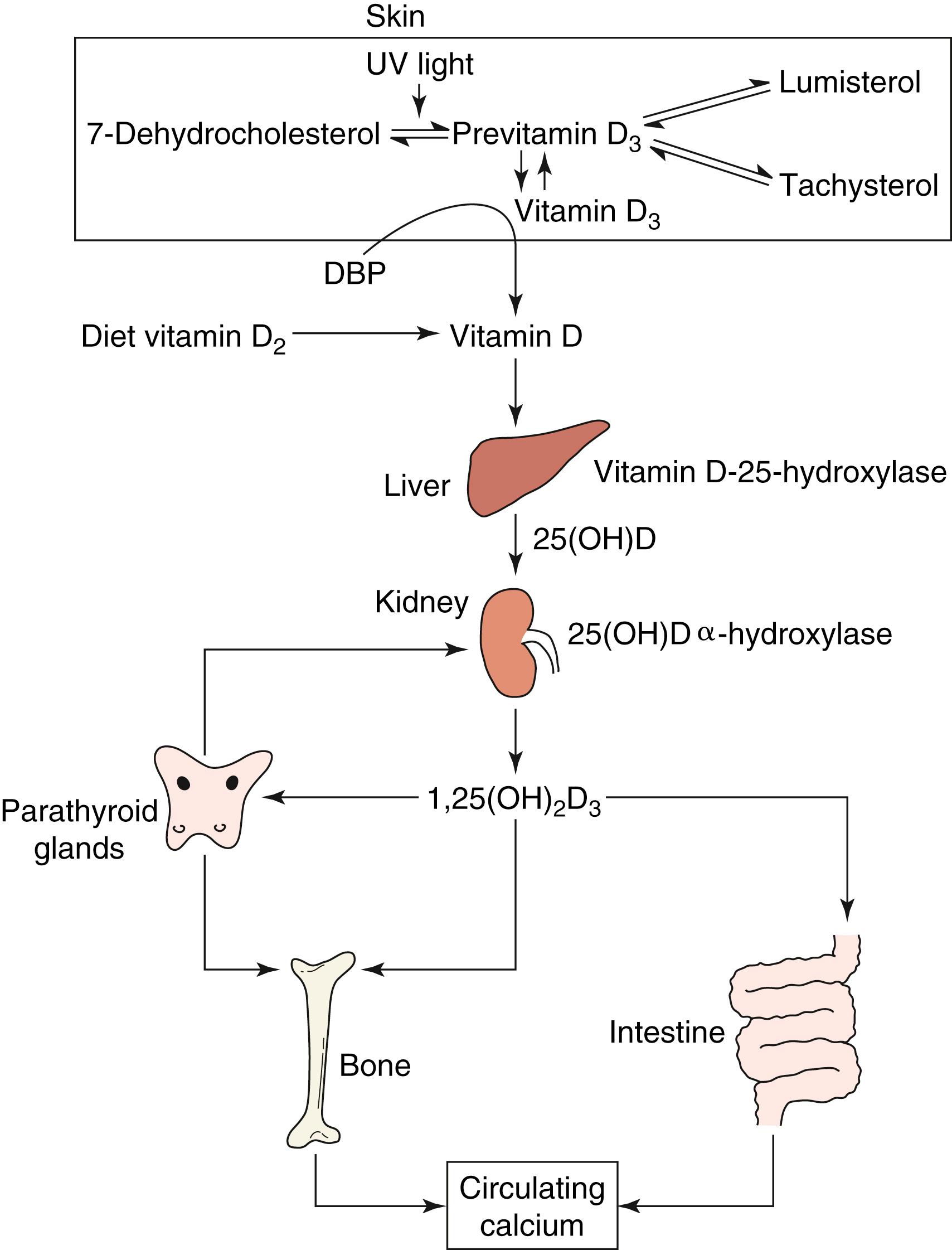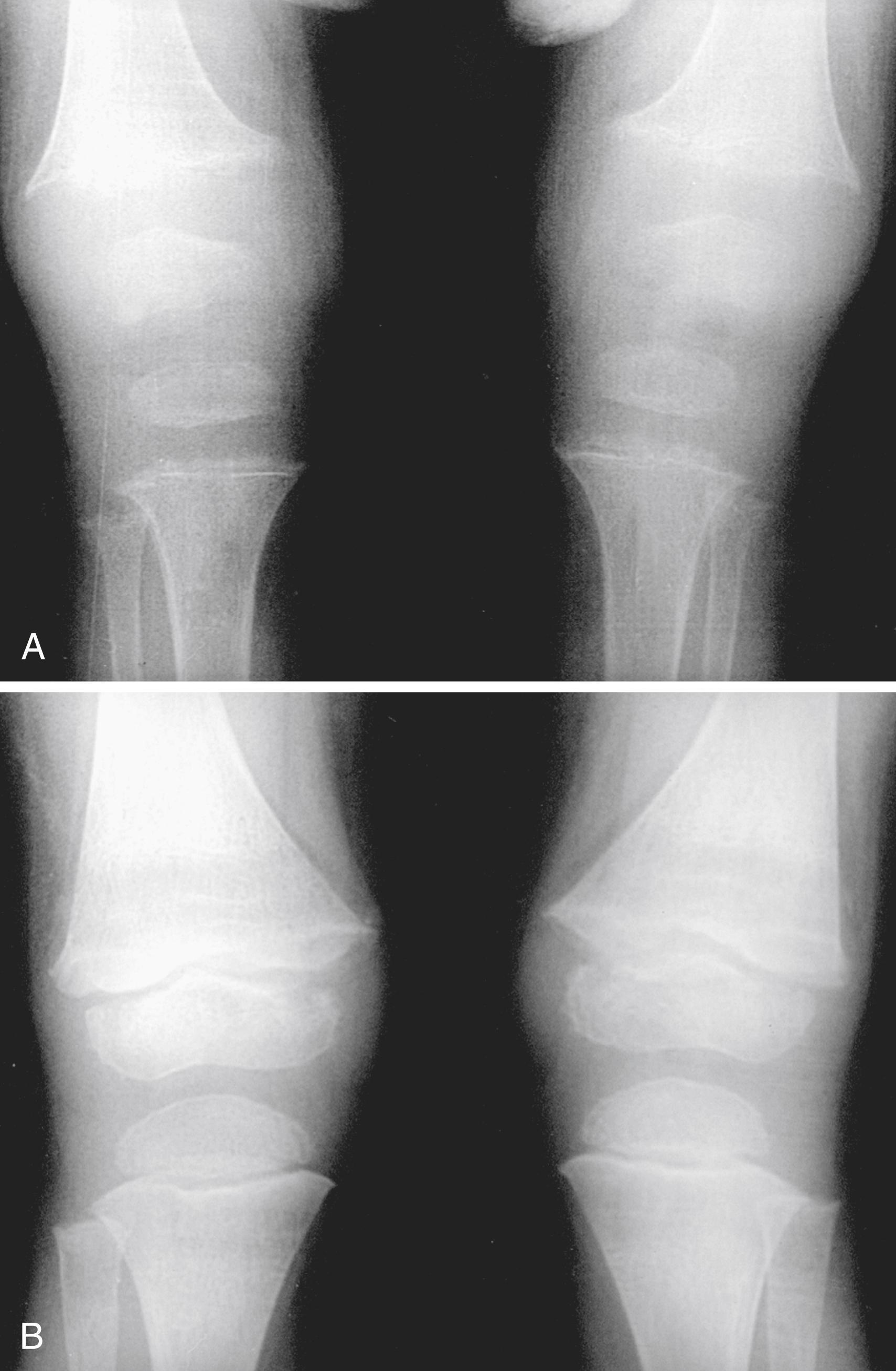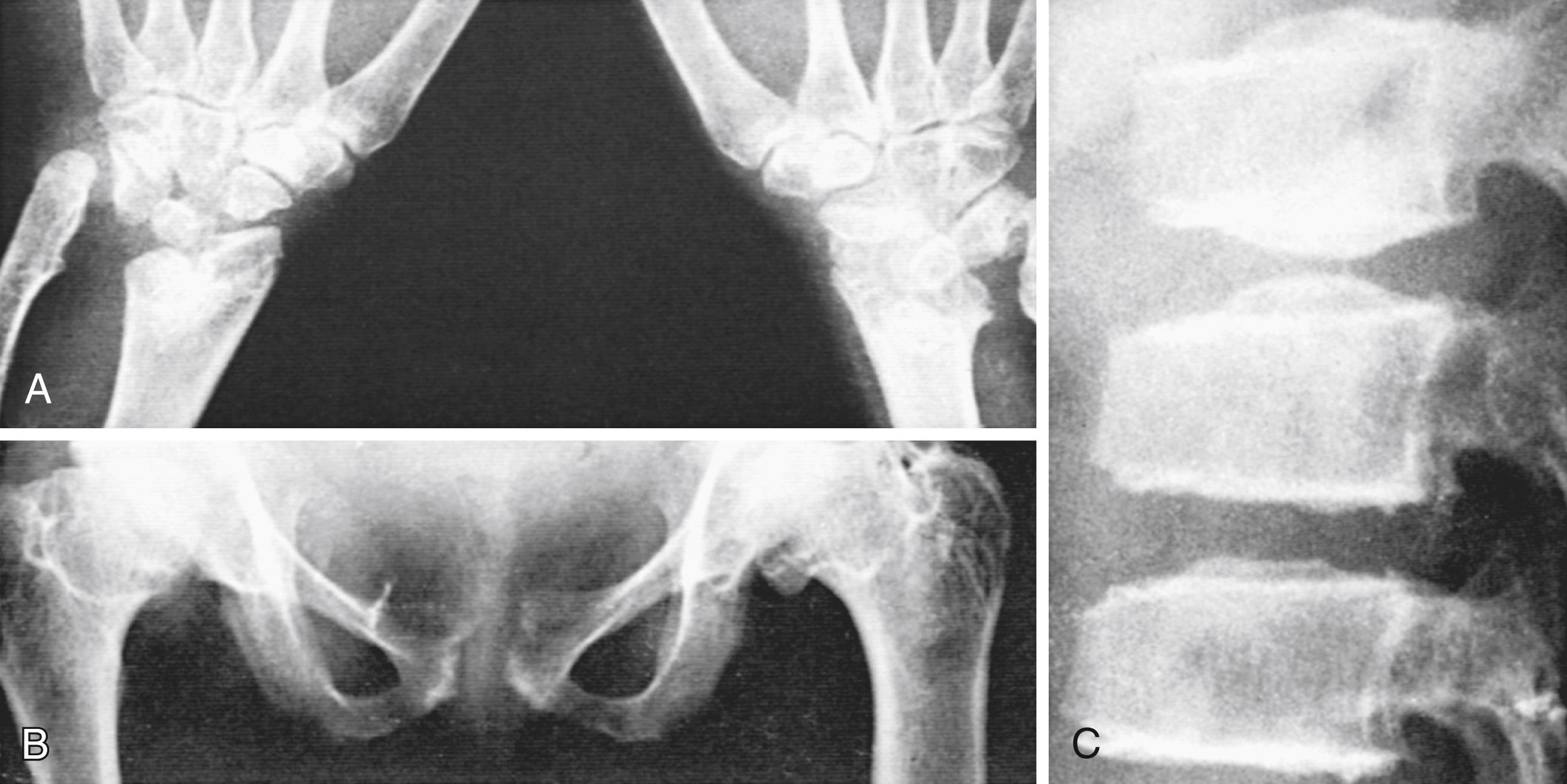Physical Address
304 North Cardinal St.
Dorchester Center, MA 02124
Many nonrheumatic systemic disorders cause musculoskeletal signs or symptoms, most commonly arthralgia, arthritis, myalgia, or bone pain. They can mimic rheumatic diseases, and it is therefore important to be aware of these conditions to avoid delay in the correct diagnosis. This chapter outlines some systemic disorders that may present in the guise of a rheumatic disease, and we aim to highlight features to suggest the conditions. Rheumatic manifestations of malignancies are discussed in Chapter 47 .
Rickets and osteomalacia are diseases associated with defective ossification of bone matrix. Rickets is a disease of the physis and only occurs in children. Osteomalacia is a disease affecting the other sites of bone formation, occurring in all ages. , Rickets has many causes, which can be identified as being either calcipenic (mostly related to deficiency of the active form of vitamin D [1,25-dihydroxyvitamin D 3 ] or calcium deficiency) or phosphopenic (mostly resulting from renal wasting of phosphate) ( Table 52.1 ).
| Type | Cause or Biochemical Abnormality |
|---|---|
| Vitamin D deficiency | Exclusion from light or insufficient dietary vitamin D |
| Calcium deficiency | Impaired calcium absorption in celiac disease, inflammatory bowel disease, scleroderma, or liver disease |
| Vitamin D resistance | Impaired parathormone-dependent proximal renal tubular reabsorption of phosphate |
| Vitamin D dependence | |
| Type 1 | Defect in renal 1-α-hydroxylase |
| Type 2 | End-organ unresponsiveness to 1,25-dihydroxyvitamin D 3 |
| Hypophosphatasia | Decreased serum alkaline phosphatase |
Most cases of rickets worldwide result from exclusion from the sun for social or cultural reasons or from insufficient dietary intake of vitamin D. Rickets is more common in dark-skinned children living in colder climates and needs to be considered in the context of global migration; screening of at-risk groups is advocated. Vitamin D deficiency rickets is seldom encountered in developed countries , but may develop despite sufficient dietary vitamin D with impaired absorption because of celiac disease, inflammatory bowel disease, scleroderma, or liver disease. Maternal vitamin D insufficiency can influence fetal bone development as early as 19 weeks’ gestation. In the absence of vitamin D supplementation, the impact on the infant may be further compounded with breast-feeding. Some types (i.e., hypophosphatemic rickets and rickets associated with hypophosphatasia) are associated with defective mineralization and are classified as osteochondrodysplasias, as discussed in Chapter 49 . Disorders such as cystinosis (resulting in renal tubular acidosis) may present as rickets with joint pain and metaphyseal enlargement ( Fig. 52.1 ). Administration of some anticonvulsant medications interferes with vitamin D metabolism and may be a cause of rickets in children deprived of sunlight.

The normal source of vitamin D 3 in humans is the skin; ultraviolet rays of sunlight convert 7-dehydrocholesterol into the vitamin prohormone, which is subsequently transformed to the 25-hydroxy form in the liver and then to active 1,25-dihydroxyvitamin in the kidney ( Fig. 52.2 ). A deficiency of 1,25-dihydroxyvitamin D 3 may result from a nutritional deficiency, from hepatic failure to convert vitamin D to 25-hydroxyvitamin D, or from failure of the kidney to convert 25-hydroxyvitamin D to 1,25-dihydroxyvitamin D 3 .

Hypophosphatemic vitamin D–resistant rickets, when expressed in infancy, leads to short stature, bowing of the legs, and ectopic calcification. , This disorder is inherited as an X-linked recessive or autosomal dominant trait, although sporadic cases occur. The basic defect is impaired parathormone-dependent proximal renal tubular reabsorption of phosphate. A low serum phosphate concentration with a normal calcium level is characteristic.
Type I vitamin D–dependent rickets is an autosomal recessive defect in renal 1-α–hydroxylase that results in failure of hydroxylation of 25-hydroxyvitamin D to 1,25-dihydroxyvitamin D 3 . The onset of typical features of rickets occurs before the age of 2 years. Type II vitamin D–dependent rickets is rare and characterized by defective intracellular interaction between 1,25-dihydroxyvitamin D 3 and its receptor. Symptoms of rickets begin in early infancy. Alopecia and absence of eyelashes occur frequently in this disorder.
Hypophosphatasia, a rare autosomal recessive disorder caused by a mutation in the gene for tissue-nonspecific alkaline phosphatase (TNSALP), presents in infancy as severe rickets and fractures. , Band keratopathy, proptosis, and papilledema develop, along with possible early loss of teeth. Chondrocalcinosis and pseudogout may be associated features. There is a marked depression in the concentration of serum alkaline phosphatase. Treatment with nonsteroidal antiinflammatory drugs (NSAIDs) may lead to symptomatic improvement. A chronic nonbacterial osteomyelitis-like syndrome in childhood hypophosphatasia is reported, the diagnosis of which should be suspected in the context of the clinical features and low serum alkaline phosphatase levels. TNSALP mutation analysis is commercially available.
The child with rickets presents with joint pain and tenderness over the bones. Bowing of the long bones and splaying of the rib cage are characteristic features. Proximal muscle weakness, particularly of the lower extremities, is occasionally prominent. Rickets can occasionally mimic inflammatory arthritis. Defective bone growth results from suppression of calcification and maturation of epiphyseal cartilage. The result is a wide, frayed, irregular zone of uncalcified osteoid at the epiphyseal line—the rachitic metaphysis ( Fig. 52.3 ).

A controversial area is whether vitamin D deficiency in the asymptomatic child needs to be treated, and what is the role for vitamin D supplementation in the child with widespread aches and pains. The threshold for deficiency in asymptomatic individuals is debated: a typical cutoff is 25 mm/L 25(OH) vitamin D. Below this, either treatment or supplementation is given. Sufficiency is generally accepted as being >75 mmol/L.
Ascorbic acid (vitamin C) is required for the formation of normal collagen and chondroitin sulfate. Vitamin C is neither synthesized nor stored in the body, and in the malnourished child a deficiency of dietary vitamin C may lead to scurvy with poor collagen synthesis and intradermal, gingival, and subperiosteal hemorrhage. Subperiosteal hemorrhage results in severe bone pain in the arms and legs; the child, usually an infant, assumes the flexed posture of pseudoparalysis and is irritable when picked up. Synovitis is rare, but hemarthroses may occur. In severe cases “scorbutic beads,” resulting from subluxation of the sternum at the costochondral junctions, may be visible on physical examination. Radiographs demonstrate subperiosteal new bone apposition. Treatment with oral or parenteral vitamin C results in definite improvement within 2 weeks.
A large number of physiological functions, organogenesis, and embryogenesis are affected by vitamin A and the derivative retinoids. Excess intake of vitamin A or retinoids causes pain in the extremities, irritability, apathy, alopecia, and delayed growth. Cortical hyperostosis (e.g., metatarsal bones, ulnas, spine) is a typical radiographic finding. Abnormal epiphyseal growth and periosteal new bone apposition occur occasionally.
These conditions need to be considered in the context of musculoskeletal presentations in a child living or having traveled to the endemic areas.
An endemic progressive osteoarthropathy primarily affecting children between the ages of 5 and 15 years, Kashin–Beck disease has a prevalence of 1% to 2% in affected areas of Tibet, northwestern China, northeastern Russia, and North Korea. There are no systemic or visceral manifestations. The etiology is uncertain, but it may result from Fusarium mycotoxins in fungus-infected grain or from selenium or iodine deficiency. There is depletion of aggregating proteoglycan (aggrecan), which results in an epiphyseal dysplasia from a zonal necrosis of chondrocytes of the epiphyses and metaphyses. These abnormalities increase in severity as long as the child lives in the endemic area and eats foods made with the contaminated grain. Excessive amounts of iron in the water and diet may contribute further to the polyarthritis. A genetic influence has been proposed in humans and in a murine model. Differences in gene expression by osteoarthritis cartilage and cartilage from adults with Kashin–Beck disease imply different pathogenic mechanisms.
Kashin–Beck disease causes symmetrical polyarthritis and progressive enlargement and limitation of motion involving multiple joints (i.e., elbows, interphalangeal joints, wrists, knees, and ankles). , In the school-age child, morning stiffness, aching, and muscle weakness are the initial symptoms mimicking inflammatory arthritis. Joint effusions and laboratory indices of inflammation are absent early in the disease. The eventual dwarfing, epiphyseal deformity, and short digits resemble those encountered in the lysosomal storage diseases. Radiographic findings include irregular erosions of the small bones of the hands and feet. Treatment with selenium may be beneficial. Although iodine supplementation may be important, iodine deficiency is not thought to be a causative factor.
Mseleni joint disease is a chronic polyarthritis of unknown etiology that affects a large proportion of the Tsonga population of the Mseleni area of northern Zululand on the eastern seaboard of South Africa. Onset of joint pain in childhood or adolescence is the first symptom of the disease. Restriction of movement and limitation of mobility develop at a variable rate. Mild stunting of growth is common, and a few patients develop severe dwarfing ( Table 52.2 ). Life spans are normal. Characteristic radiographic abnormalities include irregularity of the surface, density, and shape of the epiphyses that progresses to a secondary osteoarthritis; in the hips, which bear the brunt of the disease, protrusio acetabuli occurs in girls ( Fig. 52.4 ). Short metacarpals, ulna, and radius, and a deformity of the distal end of the ulna are also present. The diagnosis is usually obvious in the geographical and racial context, but the clinical presentation may suggest cretinism, brucellosis, hemochromatosis, alkaptonuria, and Legg–Calvé–Perthes disease at different stages of its development. Hips, knees, and ankles are the predominant sites of involvement. Handigodu syndrome, an idiopathic familial arthropathy found in a small area of southern India, closely resembles Mseleni joint disease, both clinically and radiographically.
| Characteristic | Mseleni Joint Disease | Kashin–Beck Disease |
|---|---|---|
| First noted at age | 6 years to adult | 6–10 years |
| Inherited | Probably not | Probably not |
| Sex ratio | More girls | More boys |
| Stunting of growth | Slight to severe | Moderate |
| Posture | Lumbar lordosis, genu valgum | Lumbar lordosis, neck extended, knees flexed |
| Precocious osteoarthritis | Yes | Yes |
| Radiology | Fragmented epiphyses, flared metaphyses, brachymetacarpia, protrusio acetabuli, platyspondyly | Dysplastic interphalangeal, wrist, knee, ankle joints intraarticular loose bodies |

Fluorosis is endemic in certain areas of the world, particularly Asia and Africa, and results in chronic rheumatic symptoms in children. High levels of fluoride may occur naturally in the water supply or may result from pollution. Radiologically identified skeletal fluorosis was reported in 8% of children living in households with indoor coal-burning stoves in southern China, and in 4.4% of children in an area of Tanzania with high water-fluoride content. Dental fluorosis is an early sign of toxicity. Knee pain is often an early symptom, followed by limb, hand, or characteristic spinal abnormalities that suggest a chronic inflammatory arthropathy. Radiographs demonstrate increased bone density and later show calcification of the spinal ligaments, intervertebral disks, and entheses. Cord compression can result from narrowing of the spinal canal. There is a marked periosteal reaction in the long bones.
The term gout refers to a group of disorders characterized by hyperuricemia and deposition of monosodium urate monohydrate crystals in joints and tissues. Major clinical manifestations include an acute monoarthritis, most commonly in the first metatarsophalangeal joint; chronic erosive arthritis associated with subcutaneous periarticular deposits of urate (tophi); and nephrolithiasis, often leading to chronic renal failure.
Serum urate levels increase normally at puberty, particularly in men, from approximately 3.5 mg/dL (0.21 mmol/L) in childhood to an upper limit of 7 mg/dL (0.42 mmol/L) in adult men, and 6 mg/dL (0.36 mmol/L) in adult women. Above these concentrations, the serum becomes saturated with urate.
Gout results after prolonged hyperuricemia and occurs from increased production or decreased excretion of uric acid ( Box 52.1 ). The diagnosis is confirmed by demonstration with polarized light microscopy of negatively birefringent, needle-shaped monosodium urate crystals in synovial fluid or tophi aspirate ( Fig. 52.5 ). Ultrasound is the best imaging modality to help establish diagnosis in adults by detection of either asymptomatic tophi or a double contour sign at cartilage surface, which is highly specific for gout. Magnetic resonance imaging (MRI) and dual-energy computed tomography are also used to demonstrate urate in tophi. , Treatment of the acute attack with NSAIDs such as indomethacin, or with colchicine, is usually effective. Short-term corticosteroids or intraarticular steroid injections may also be used. After the acute episode has subsided, allopurinol is the drug of choice for prevention of recurrences. In adults, use of interleukin (IL)-1 blockade is recommended for those with contraindication or resistance to colchicine, NSAIDs, and corticosteroids. ,
Become a Clinical Tree membership for Full access and enjoy Unlimited articles
If you are a member. Log in here